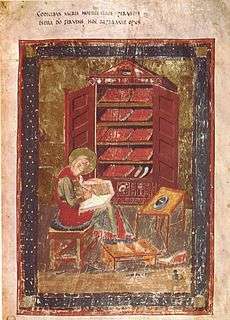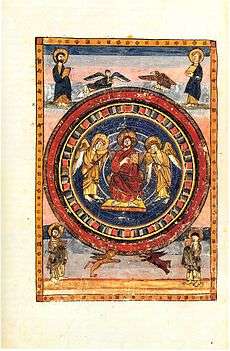Codex Amiatinus

The Codex Amiatinus, is the earliest surviving complete manuscript of the Latin Vulgate version[1] of the Christian Bible. It was produced around 700 C.E. in the north-east of England, at the Benedictine monastery of Wearmouth-Jarrow in the Anglo-Saxon Kingdom of Northumbria and taken to Italy as a gift for the Pope in 716. It was one of three giant single-volume Bibles then made at Wearmouth-Jarrow, and is the earliest complete one-volume Latin Bible to survive, only the León palimpsest being older; and the oldest bible where all the biblical books present what would be their Vulgate texts.
It is named after the location in which it was found in modern times, Mount Amiata in Tuscany, at the Abbazia di San Salvatore and is now kept at Florence in the Biblioteca Medicea Laurenziana[2] (Amiatino 1).
Designated by siglum A, it is commonly considered to provide the most reliable surviving representation of Jerome's Vulgate text for the books of the New Testament, and most of the Old Testament. As was standard in all Vulgate bibles until the 9th century, the Book of Baruch is absent[2] as is the Letter of Jeremiah, the text of the Book of Lamentations following on from the end of Jeremiah without a break. Ezra is presented as a single book, the texts of the later canonical books of Ezra and Nehemiah being continuous. Similarly the books of Samuel, Kings and Chronicles are each presented as a single book.
It was announced in 2017 that the Codex Amiatinus would be loaned to the British Library in 2018 for an exhibition of Anglo-Saxon manuscripts, and would thus be returning to England for the first time in 1,302 years.[3]
Description


The symbol for it is written am or A (Wordsworth). It is preserved in an immense tome, measuring 19 1⁄4 inches (49 cm) high, 13 3⁄8 inches (34 cm) in breadth, and 7 inches (18 cm) thick, and weighs over 75 pounds (34 kg) — so impressive, as Hort says, as to fill the beholder with a feeling akin to awe.[4][5][2]
The Book of Psalms is provided in Jerome's third version, translated from the Hebrew, rather than in the pre-Jerome Roman Psalter then standard in English bibles, or in Jerome's second, Gallican version, that was to supplant his Hebraic Psalms in most Vulgate bibles from the 9th century onwards. By contrast with case in most of the rest of the Old Testament, the Amiatinus psalms text is commonly considered an inferior witness of Jerome's Versio juxta Hebraicum; the presence of the 'Columba' series of psalm headings, also found in the Cathach of St. Columba, demonstrates that an Irish psalter must have been its source; but the text differs in many places from the best Irish manuscripts. The New Testament is preceded by the Epistula Hieronymi ad Damasum, Prolegomena to the four Gospels.
The Codex Amiatinus qualifies as an illuminated manuscript as it has some decoration including two full-page miniatures, but these show little sign of the usual insular style of Northumbrian art and are clearly copied from Late Antique originals. It contains 1040 leaves of strong, smooth vellum, fresh-looking today despite their great antiquity, arranged in quires of four sheets, or quaternions. It is written in uncial characters, large, clear, regular, and beautiful, two columns to a page, and 43 or 44 lines to a column. A little space is often left between words, but the writing is in general continuous. The text is divided into sections, which in the Gospels correspond closely to the Ammonian Sections. There are no marks of punctuation, but the skilled reader was guided into the sense by stichometric, or verse-like, arrangement into cola and commata, which correspond roughly to the principal and dependent clauses of a sentence. From this manner of writing the script is believed to have been modeled upon the Codex Grandior of Cassiodorus,[6] but it may go back, perhaps, even to St. Jerome.[2]
History
.jpg)
Originally three copies of the Bible were commissioned by Abbot Ceolfrid in 692.[1] This date has been established as the double monastery of Wearmouth-Jarrow secured a grant of additional land to raise the 2000 head of cattle needed to produce the vellum. Bede was most likely involved in the compilation. In 716, Ceolfrid accompanied one copy, the Codex Amiatinus, intended as a gift to Pope Gregory II, but he died en route to Rome on 29 September 716 at Langres, Burgundy.[7][1] The book later appears in the 9th century in Abbey of the Saviour, Mount Amiata in Tuscany (hence the description "Amiatinus"), where it remained until 1786 when it passed to the Laurentian Library in Florence. The dedication page had been altered and the principal librarian to the Laurentian, Angelo Maria Bandini suggested that the author was Servandus, a follower of St. Benedict, and that it had been produced at Monte Cassino around the 540s. This claim was accepted for the next hundred years, establishing it as the oldest copy of the Vulgate, but scholars in Germany noted the similarity to 9th-century texts. In 1888, Giovanni Battista de Rossi established that the Codex was related to the Bibles mentioned by Bede. This also established that Amiatinus was related to the Greenleaf Bible fragment in the British Library. Although de Rossi's attribution removed 150 years from the age of the Codex, it remains the oldest version of the Vulgate.
As the primary source of the Vulgate, the manuscript was of particular importance to the Catholics during the Counter-Reformation. Protestant translations derived from the original language of the Scriptures, but the Latin text of the Amiatinus was earlier than any then-known Hebrew manuscript, making it a "major piece of propaganda in the battle for textual precedence". In 1587 Pope Sixtus V demanded the book be sent to Rome where it was used as the principal source for a new papal edition of the Bible, the Vulgata Sixtina;[8] although in the event, little or no use was made of its readings in either the Sistine or subsequent Sixto-Clementine official Vulgate editions.
In view of the many accumulated corruptions in all published editions of the Vulgate so far, the Oxford University Press accepted in 1878 a proposal from classicist John Wordsworth (later Bishop of Salisbury) to produce a new critical edition of the Vulgate New Testament.[9][10] This was eventually published as Nouum Testamentum Domini nostri Iesu Christi Latine, secundum editionem sancti Hieronymi in three volumes between 1889 and 1954;[11] the Codex Amiatinus being a primary source for the entire text; which also followed this manuscript in presenting the text in sense lines, cola et commata without any other indication of punctuation. In 1907 Pope Pius X commissioned the Benedictine monks in Rome to prepare a critical edition of Jerome's Vulgate, entitled Biblia Sacra iuxta latinam vulgatam versionem, which eventually emerged as a counterpart Old Testament to the Oxford New Testament, following largely the same critical principles, and according similar primary status to the Codex Amiatinus text (other than for the Psalms); and similarly deriving its layout, cola et commata from Amiatinus.[12]
See also
- List of New Testament Latin manuscripts
- Celt (tool) – a famous mistake in most Vulgates, not found in this copy
- Ceolfrid Bible - almost certainly a surviving portion of one of the other two single-volume Bibles ordered made by Ceolfrid for the double monastery of Jarrow/Wearmouth.
References
- 1 2 3 Bruce M. Metzger, The Text of the New Testament (Oxford University Press 2005), p. 106.
- 1 2 3 4

- ↑ https://www.telegraph.co.uk
- ↑ H. J. White, The Codex Amiatinus and its Birthplace, in: Studia Biblica et Ecclesiasctica (Oxford 1890), Vol. II, p. 273.
- ↑ Richard Marsden, Amiatinus, Codex, in: Blackwell encyclopaedia of Anglo-Saxon England, ed. Michael Lapidge,John Blair,Simon Keynes, Wiley-Blackwell, 2001, s. 31.
- ↑ Dom John Chapman, The Codex Amiatinus and the Codex grandior in: Notes on the early history of the Vulgate Gospels, Clarendon Press, Oxford 1908, pp. 2–8.
- ↑ Hind, George. "St. Ceolfrid." The Catholic Encyclopedia. Vol. 3. New York: Robert Appleton Company, 1908. 17 May 2013
- ↑ De Hamel, p.64
- ↑ Wordsworth, John (1883). The Oxford critical edition of the Vulgate New Testament. Oxford. p. 4.
- ↑ Watson, E.W. (1915). Life of Bishop John Wordsworth. London: Longmans, Green.
- ↑ Nouum Testamentum Domini nostri Iesu Christi Latine, secundum editionem sancti Hieronymi. John Wordsworth, Henry Julian White (eds.). Oxford: Clarendon Press. 1889–1954. 3 vols,
- ↑ Biblia Sacra iuxta latinam vulgatam versionem. Pontifical Abbey of St Jerome-in-the-City (ed.). Rome: Libreria Editrice Vaticana. 1926–95. ISBN 8820921286. 18 vols.
Further reading
- Chapman, John (1908). Notes on the early history of the Vulgate Gospels. Oxford: Clarendon Press. Retrieved 2015-12-13.
- Chazelle, Celia (2003). "Ceolfrid's gift to St Peter: the first quire of the Codex Amiatinus and the evidence of its Roman destination". Early Medieval Europe. 12 (2): 129–157. doi:10.1111/j.0963-9462.2004.00124.x. ISSN 1468-0254. Retrieved 2015-12-04.
- Chazelle, Celia (2006). "Christ and the vision of God: the Biblical diagrams of the Codex Amiatinus". In Jeffrey F. Hamburger, Anne-Marie Bouché (eds.). The mind's eye: art and theological argument in the Middle Ages. Princeton, NJ: Princeton University Press. pp. 84–111. ISBN 978-0-691-12475-9.
- Corsano, Karen (1987). "The First Quire of the Codex Amiatinus and the Institutiones of Cassiodorus". Scriptorium. 41 (1): 3–34. doi:10.3406/scrip.1987.1462. ISSN 0036-9772. Retrieved 2015-12-13.
- Meyvaert, Paul (1996). "Bede, Cassiodorus, and the Codex Amiatinus". Speculum. 71 (4): 827–883. doi:10.2307/2865722. ISSN 0038-7134. JSTOR 2865722.
- Meyvaert, Paul (2005). "The date of Bede's In Ezram and his image of Ezra in the Codex Amiatinus". Speculum. 80 (4): 1087–1133. doi:10.1017/S0038713400001366. ISSN 2040-8072. Retrieved 2015-12-04.
- Sanday, W. (1890). "On the Italian origin of the Codex Amiatinus and the localizing of Italian MSS.". Studia Biblica et ecclesiastica: essays chiefly in Biblical and patristic criticism. 2. Oxford: Clarendon Press. pp. 309–324.
- Tischendorf, Constantinus von (1850). Novum Testamentum Latine interprete Hieronymo: ex celeberrimo Codice Amiatino. Leipzig: Avenarius et Mendelssohn. Retrieved 2015-12-04.
- White, H.J. (1890). "The Codex Amiatinus and its birthplace". Studia Biblica et ecclesiastica: essays chiefly in Biblical and patristic criticism. 2. Oxford: Clarendon Press. pp. 273–308.
- The City and the Book: International Conference Proceedings, Florence, 2001.
- Alphabet and Bible: From the Margins to the Centre. Paper at Monte Amiata, 2009. https://web.archive.org/web/20090803165921/http://www.florin.ms/AlphabetBible.html
- Makepeace, Maria. "The 1,300 year pilgrimage of the Codex Amiatinus". Umilta Website. Retrieved 2006-06-07. Contains link to facsimile project, as well.
- de Hamel, Christopher (2016). Meetings with Remarkable Manuscripts. Allen Lane. ISBN 978-0-241-00304-6.
External links
| Wikimedia Commons has media related to Codex Amiatinus. |
- Codex Amiatinus: Complete images through the World Digital Library
- Florence, Biblioteca Medicea Laurenziana, Amiat. 1, bibliography
- Image of the codex, folio 950
- British Library blogpost
- David Dimbleby. "Age of Conquest". Seven Ages of Britain. 33:38 minutes in. BBC 1. Retrieved 21 Nov 2010.
- The Cambridge History of the Bible, Cambridge University Press 2008, pp. 117–119, 130.
- More information at Earlier Latin Manuscripts.